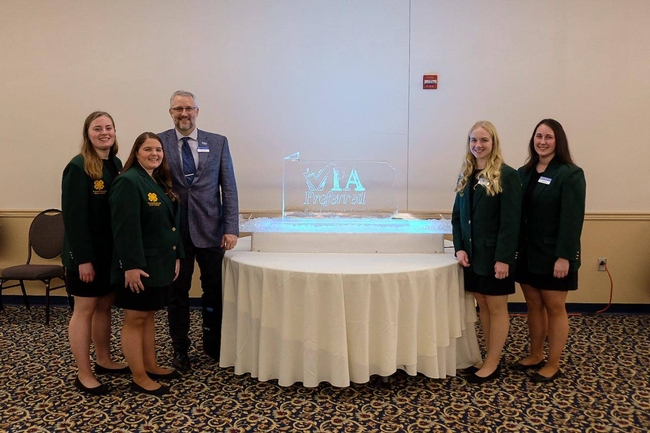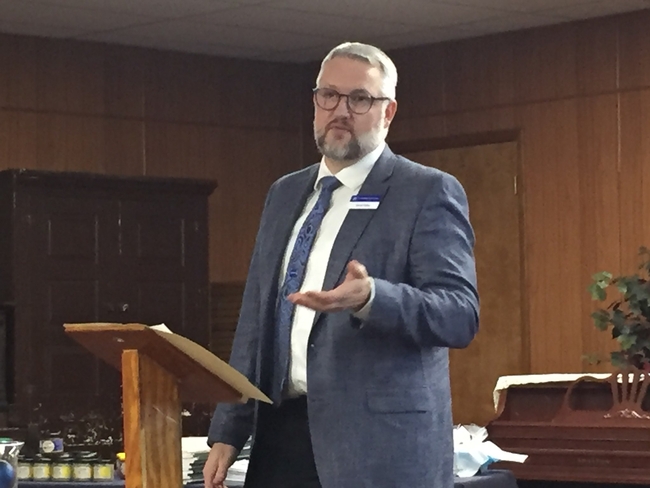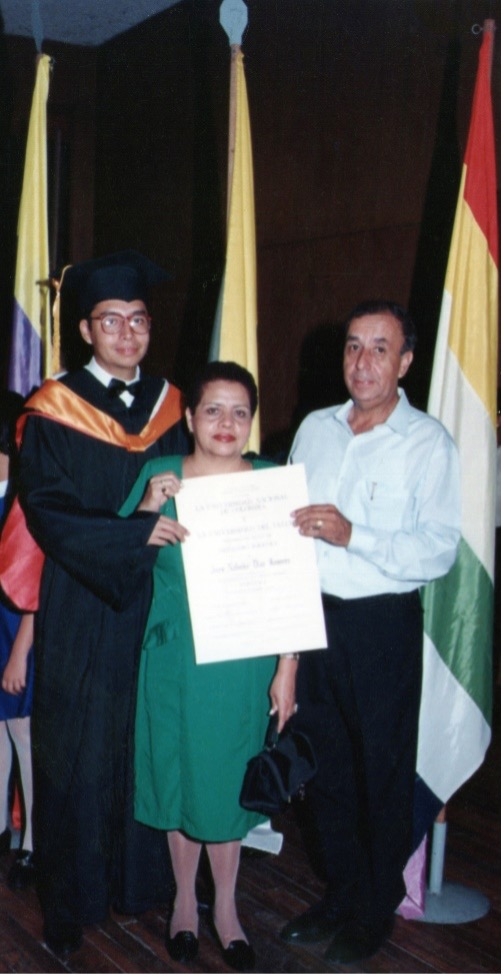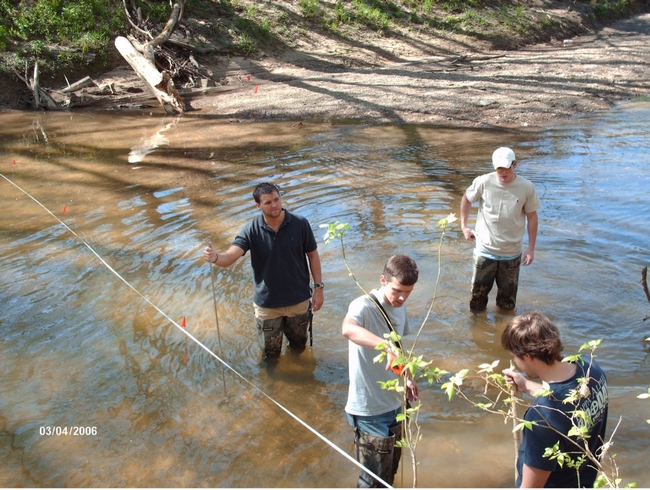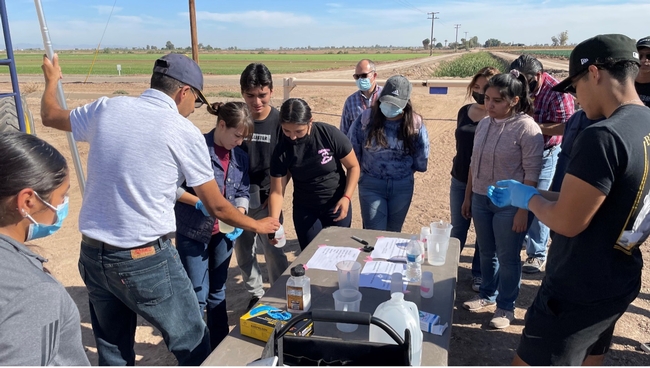- Author: Mike Hsu
Between 4th and 8th grade, Brent Hales had acquired from those years in 4-H a lifetime's worth of skills, a group of lifelong friends, an expanded perspective on the world – and the track suit of his dreams.
The middle child of seven kids, young Brent knew his family couldn't afford to buy a track suit off the rack. So he saved up money, bought the Navy blue fabric and pattern, and took on sewing as one of his many 4-H projects during the 1980s. Just one problem: he ended up making it inside-out, with the fuzzy side facing outward.
“And then, by the time I actually completed it, I had outgrown it, so I gave it to my younger brother,” Hales recalled with a laugh.
Hales still enjoys sewing, although he rarely finds time for it, given his many duties as UC Agriculture and Natural Resources' associate vice president for research and Cooperative Extension.
One of his responsibilities is helping to oversee the 4-H program in California, which, along with its counterparts across the country, is celebrating National 4-H Week Oct. 1–7. In a recent interview, Hales shared some of his favorite experiences as a 4-H club member growing up in Aurora, Utah, as well as some of the enduring impacts from his participation.
The mere mention of 4-H must bring back a torrent of memories, images and stories. Can you share one experience that stands out for you?
At the end of the summers, the leader of our horse club, Dan Thompson, would take us on a weeklong horse ride. In order to qualify, you had to demonstrate horsemanship, you had to be able to take care of your horse, and show a certain amount of leadership.
Dan had the kids take the lead; he planned the route but then he would ride in the back. Each day of the horse ride, we would take turns at various aspects of leadership within the week. We would get to a point and we would discuss where we were going; we would discuss points along the trail that we needed to be looking for. But, invariably, all with him in the back, allowing us to lead. He wanted us to lead the whole thing.
You could imagine sending a group of 11-, 12-, 13-year-old kids on a weeklong horse ride with a guy would be daunting enough. But the most important thing you need to understand is the amount of trust that we had in him, he had in us, and our parents had in him – because Dan was blind.
He had gone blind late in life. He knew the trails well enough that he could describe what we were going to see, and he could describe where we were going to stay, but he left it up to us to share information and lead.
You think about the types of skills that it taught us – I have cold chills thinking about that – and the confidence that it instilled in us was so powerful. In a community where less than half of the kids went on to a four-year degree program, all 11 of us in the horse club completed four-year degrees, and all of us are continuing to be very successful.
In addition to leadership skills, public-speaking skills, sewing skills and horsemanship…what else did 4-H teach you?
We actually got involved quite a bit in the arts – the visual arts, the performing arts. Because of that, I went to college on a vocal performance scholarship, which I tie right back to 4-H.
We put on an annual musical at the county fair, which translated to being involved in musicals at school and other performing groups. It paved the way for me to go to a much better school than probably was in my academic trajectory otherwise, so I went to BYU as an undergrad.
I realized very quickly how out-classed I was in terms of the vocal performance and ultimately changed majors – but I stayed involved and had the opportunity to do quite a bit of traveling and touring with various musical groups. In the last three years, I've sang at both Carnegie Hall and the Kennedy Center, as part of ensembles and groups. What a long tail my 4-H involvement has had, in encouraging my love of music and of performing!
In what other ways did 4-H shape who you are today, personally and in your career trajectory?
My hometown of Aurora was settled by my fourth great-grandfather, so I was actually related to about 85% of that small town. And so I had a very myopic view of what the world looked like.
What 4-H did was it showed me that there's a much larger world out there. Because of 4-H, I engaged with different kids from different backgrounds, different ideologies, different life expectations than that of my own. And it opened a world I never knew existed, number one, and that I had a place in that world.
So the thought of moving from my safe, rural community…when I was a little kid, that was the last thing that I wanted. But after engaging with kids from not just across Utah, not just across the country, but across the world, it created a hunger in me to learn and to know and to experience. And that has yet to be satisfied!
Every time I remember and relive my 4-H years, I'm reminded of why I do this job – to enable others, perhaps, to be that kid that I was, and see beyond what their worldview is, or the limitations of their culture, identity and hometown.
On top of your 4-H role as a part of the leadership team at UC ANR, you're also on the strategic planning board for the national 4-H organization. How has 4-H continued to evolve over the years?
With COVID, when I was at Penn State, we shifted online and we saw a whole new generation of kids who would not have ever joined 4-H as a result. We created statewide programs, instead of the traditional clubs, and that brought together kids who normally would not have been drawn to it. And instead of meeting face-to-face, we met virtually and we sent out activity boxes ahead of time. Then, post-COVID, what surprised us is that the online clubs – the clubs we kind of anticipated going away – those actually continued to grow.
So how we reach the kids has evolved as much as the type of kids that we are seeing come in. And it has had to – if we marketed 4-H to an ever-shrinking rural population of on-farm kids, it would quickly become irrelevant. And so the way we market to them, the way we bring them in, the way we encourage and facilitate discussion, the way topics and areas of interest are identified – those continue to evolve and I hope will drive the next iteration of what 4-H looks like. Because it doesn't look anything like what I grew up with – granted, that was a long time ago, over 40 years ago! And I would say in 10 years 4-H probably won't look like what it looks like now. And that's a good thing.
- Author: Saoimanu Sope
In celebration of Hispanic Heritage Month
In the small town of Buga, located in Valle del Cauca in southwestern Colombia, Jairo Diaz-Ramirez prioritized salsa dancing over his studies. His parents, noticing that he was having too much fun on weekends, reminded Diaz that schoolwork comes first. “I used to dance a lot and spend time with friends when I was a teenager, and I didn't pay full attention to schoolwork,” he said.
Diaz, director of the UC Desert Research and Extension Center – one of nine centers under University of California Agriculture and Natural Resources – located in Holtville, was born and raised in Colombia, where the life of a farmworker was all too familiar.
Before Diaz's father joined the army, he worked in the fields. Describing his father as an “autodidactic person,” Diaz said that his father acquired many skills throughout his life and could “fix pretty much everything.” Others knew this about Diaz's father, often referring to him as “el cientifico” or the scientist.
“My hometown is surrounded by agriculture, and I saw farmworkers all the time. What they do is difficult work, it's hard,” he said. Even though Diaz has a career in agriculture today, he did his best to avoid it when he was in school.
In high school, Diaz focused on math and science, believing it would lead him down a different career path. When he graduated in 1990, Diaz didn't have many options for a college education in his area. “There was barely internet in my hometown,” he recalled, adding that it was a challenge to find professional mentors, too.
“I didn't know what I wanted to study,” said Diaz. “But when I passed the entry test for college, I just decided on electrical engineering.” As a freshman in college, Diaz found himself in a different environment with rules and expectations he was not used to. “I lost focus,” he said.
In fact, his poor academic performance led Diaz to drop out of college. He described this decision as, “the inflection point that changed the course of his life.” Realizing that he took a great opportunity for granted, Diaz wanted to return to school. After passing the college entry exam a second time, his test results matched him to the following career options: agricultural, sanitary or chemical engineering.
Because it required fewer chemistry courses, Diaz decided to pursue agricultural engineering. The more he learned, the more interested he became in irrigation, watershed management, soil and water conservation. In 1997, he obtained a bachelor's degree in agricultural engineering from National University of Colombia and University of Valle.
Realizing there's more to agriculture
There was a shift in perspective that occurred for Diaz, one that made him see other pathways into agriculture other than farm labor.
“I always saw the workers in the field from four in the morning to six at night, even on Saturdays,” Diaz said. “But I never saw what was behind agriculture. Labor is one thing, but there's also the science, education, management, engineering… I didn't see that when I was younger.”
In 2001, after two years of working as a part-time instructor at community colleges in his hometown, Diaz moved to Puerto Rico, where he earned a master's degree in water resources engineering from University of Puerto Rico. Although he would have liked to attend graduate school in his home country, career opportunities were limited.
“I considered schools in Spain and Chile, somewhere the people speak Spanish,” said Diaz, sharing that the ability to learn in Spanish was his preference.
Meeting students halfway
Eventually, Diaz moved to Mississippi, earning a doctorate in water resources engineering at Mississippi State University before he began teaching at Alcorn State University – the oldest public historically Black land-grant institution in the nation – where his role as a mentor easily became his favorite part of that journey.
As an assistant professor, Diaz said that many students he worked with at Alcorn State struggled with higher level courses of agriculture. “Some of my students started with me when they were freshmen and I got to see them progress over the years,” said Diaz.
Now, many of them work for the federal government and non-governmental organizations, and some have even moved to other states, away from everything and everyone they know.
“It reminds me of my own people,” Diaz said. “How challenging education can be, and how limited you feel, and being afraid to move away from home…that's what many of us BIPOC [Black, Indigenous, people of color] experience.”
Once a mentor, always a mentor
In Imperial County, where Diaz currently lives, more than 80% of the population is Hispanic. According to Diaz, many of the students in Imperial can relate to those he taught in Colombia, Puerto Rico and Mississippi, struggling to navigate education. “A lot of the students also think like me when I was their age. They don't find agriculture appealing because it's too hard.”
That's where Diaz steps in and shows them a different side of agriculture, one that he wishes someone would have shown him when he was younger. When he visits local schools, or hosts student groups at Desert REC, he teaches students that agriculture offers a broad spectrum of opportunities.
“Agriculture is not just about people in the fields, it's people in the labs, at the computers and in the classroom. It's people managing others, figuring out economics and building systems,” he said.
Given his background in hydrology, irrigation systems and water resources, Diaz relies on water as the element to engage students in conversations about agricultural careers. “To produce food, we need water. Plants need water to live and so do we. Water is key,” he tells students.
“I know how much of a difference it makes to have someone guide you professionally. So, I want to be that person for my community, especially the younger generation.”
As a director, Diaz has an open-door policy to encourage frequent interactions with his colleagues. “It's important to me that the people I work with know that I want to support them,” said Diaz, who prefers colleagues call him by his first name.
“Sometimes you hear that someone is a ‘doctor,' and it creates a divide right away,” he said.
While reflecting on his role and impact, Diaz said that he wants to be known as a genuinely good person. “I want to be a good collaborator, create meaningful programs, and grow a healthy industry.”
These days, Diaz doesn't spend much time on the dance floor, but he won't shy away from an opportunity to relive his adolescence. “I have created my own career path with the support of my family, mentors and friends,” he said. “I still have fun, but I also focus when I need to.”
To watch a past feature on Diaz in celebration of Hispanic Heritage Month, visit: https://www.youtube.com/watch?v=ksNc7qDCOVo.
To read this article in Spanish, visit: https://espanol.ucanr.edu/Abriendo_Caminos/?blogpost=58085&blogasset=139086.

